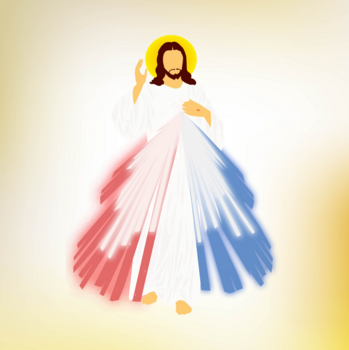Search
The Divine Mercy Image Is the Mirror Image of Our Lord’s Passion
-
 April 30, 2025St. Faustina Kowalska recorded in her diary the following words spoken to her by Our Lord concerning the Divine Mercy Image that He instructed her to have painted, “Paint an image according to the pattern you see with the signature: Jesus, I trust in You. I promise that the soul that will venerate this image will not perish. I promise also victory over enemies already here on earth, especially at the hour of death. I Myself will defend it (the soul who venerates the Image) as My own glory. (Diary, 47, 48) I desire that this image be venerated, first in your chapel, and then throughout the world”. (47)
April 30, 2025St. Faustina Kowalska recorded in her diary the following words spoken to her by Our Lord concerning the Divine Mercy Image that He instructed her to have painted, “Paint an image according to the pattern you see with the signature: Jesus, I trust in You. I promise that the soul that will venerate this image will not perish. I promise also victory over enemies already here on earth, especially at the hour of death. I Myself will defend it (the soul who venerates the Image) as My own glory. (Diary, 47, 48) I desire that this image be venerated, first in your chapel, and then throughout the world”. (47)
There is hardly a Catholic Church today where a reproduction of the Divine Mercy Image cannot be found. The message that Jesus gave to St. Faustina, a humble Polish nun, from 1931 to 1938 has spread throughout the world like wildfire. The Divine Mercy Image is an integral part of the message that proclaims God’s unfailing and all-encompassing mercy for us. Pope St John Paul II in his second encyclical letter, Dives in Misericordia (Rich in Mercy) claims that mercy is “love’s second name”. (7)
When we look at the Image of the Merciful Jesus, what do we see? Jesus is dressed in a white robe resembling the white robe or alb that a priest wears to celebrate Mass. His face exhibits a uniquely masculine beauty that portrays both tenderness and strength. His gaze is fixed upon us and follows us. His right hand is raised in a gesture of blessing. His left hand pulls back His robe from the chest seeming to expose His Heart from which emanates a red ray and a pale ray of light. Our Lord has the appearance of walking toward us with His left foot before His right one. The background of the Image is dark. Light appears to come forth from the interior of Jesus Himself. His head is surrounded by a delicate yet distinct halo of light.
What does the Image say to us? Jesus appears solid and real indicating that He took on our flesh. He who is Almighty God dwelling in eternal light became one of us and walked on the roads of this earth finally ascending the Hill of Calvary to be nailed to the Cross for our salvation. He is the True Light coming to us in a world of darkness and sin.
Jesus told St. Faustina, “My gaze from this image is my gaze from the cross.” (Diary, 326) The beauty of His countenance in the Image comes from His Heart overflowing with merciful love for us. His gaze is that of the Great High Priest and at the same time, Victim offered. In His agony and death His gaze never leaves us for whom He makes His Sacrifice of merciful love. The Face that is beaten, bruised, spat upon, whose brow is pierced with the crown of thorns, is transfigured by love and mercy into a gaze of incomparable beauty.
Our Lord’s right hand raised to bless us proves Him to be the Priest who sanctifies us and gives us life. But, how? We need only look to His left hand that points to the very fount of mercy – His Heart pierced from which flows Blood and Water symbolized by the red and pale rays reminding us of the Sacrament of Baptism (pale for water) and the Sacrament of the Most Holy Eucharist (red for the Precious Blood of Christ). The imprints of the nails can be seen on His hands showing that on the Cross His hands nailed to the wood were really raised in blessing and pointing to His Heart the fountain from which His merciful love flows.
His feet indicate that He is always bounding toward us. He left the Father’s side in the Incarnation to come to us as One of us. He freely bounded up the Hill of Calvary to offer Himself for our redemption. He comes to us with eager joy in the sacraments that He gave to the Church so that the fruit of His saving Sacrifice may be ours especially in the Sacrament of His Body and Blood at Mass.
We can truly say that the Divine Mercy Image is the mirror image of His Passion. He shows Himself in the Image to be the Priest, Victim, Vessel of Merciful love and Redeemer of us all.
Let us come before His Image of Divine Mercy and gaze upon the Light who is Hope for the whole world.
Most Reverend William J. Waltersheid
Auxiliary Bishop of Pittsburgh
